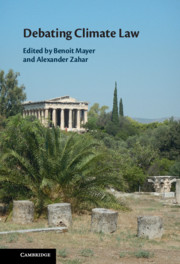Book contents
- Debating Climate Law
- Debating Climate Law
- Copyright page
- Contents
- Contributors
- Acknowledgements
- Abbreviations
- Introduction
- Debate 1: Customary Law
- Debate 2: The ILC’s Role
- Debate 3: CBDR Principle
- Debate 4: Compliance
- Debate 5: Climate Litigation
- Debate 6: Human Rights
- Debate 7: Historical Responsibility
- Debate 8: Climate Migration
- Debate 9: Negative-Emission Technologies
- Debate 10: Solar Radiation Management
- Debate 11: Climate Assessment
- Reflection 1: Adaptation
- Reflection 2: Loss and Damage
- Reflection 3: Disappearing States
- Reflection 4: Climate Finance
- Reflection 5: Non-State Actors
- Reflection 6: Regime Inconsistency
- Reflection 7: Aesthetics
- Climate Change Law and Aesthetics: A Primer
- Conclusion
- Index
Climate Change Law and Aesthetics: A Primer
from Reflection 7: Aesthetics
Published online by Cambridge University Press: 15 June 2021
- Debating Climate Law
- Debating Climate Law
- Copyright page
- Contents
- Contributors
- Acknowledgements
- Abbreviations
- Introduction
- Debate 1: Customary Law
- Debate 2: The ILC’s Role
- Debate 3: CBDR Principle
- Debate 4: Compliance
- Debate 5: Climate Litigation
- Debate 6: Human Rights
- Debate 7: Historical Responsibility
- Debate 8: Climate Migration
- Debate 9: Negative-Emission Technologies
- Debate 10: Solar Radiation Management
- Debate 11: Climate Assessment
- Reflection 1: Adaptation
- Reflection 2: Loss and Damage
- Reflection 3: Disappearing States
- Reflection 4: Climate Finance
- Reflection 5: Non-State Actors
- Reflection 6: Regime Inconsistency
- Reflection 7: Aesthetics
- Climate Change Law and Aesthetics: A Primer
- Conclusion
- Index
Summary
This chapter reviews the debates relating to the interface of climate change law and aesthetics. Global warming alters the aesthetic properties of nature, and additional aesthetic changes are precipitated by the mitigation and adaptation responses of impacted societies. Domestic legal systems already have a leading role in governing certain disputes that involve strong aesthetic elements, such as the location of wind turbines or seawall defences. The international legal system has established some regimes that explicitly engage with aesthetic values, such as the World Heritage Convention. Ben Richardson maps the views expressed in the growing scholarship on climate law’s encounters with aesthetics. The chapter also weighs different views on why aesthetic experiences might be important to better understanding the dangers of climate change, which mostly lie in the future and thus out of sight and out of mind.
Keywords
- Type
- Chapter
- Information
- Debating Climate Law , pp. 412 - 430Publisher: Cambridge University PressPrint publication year: 2021

